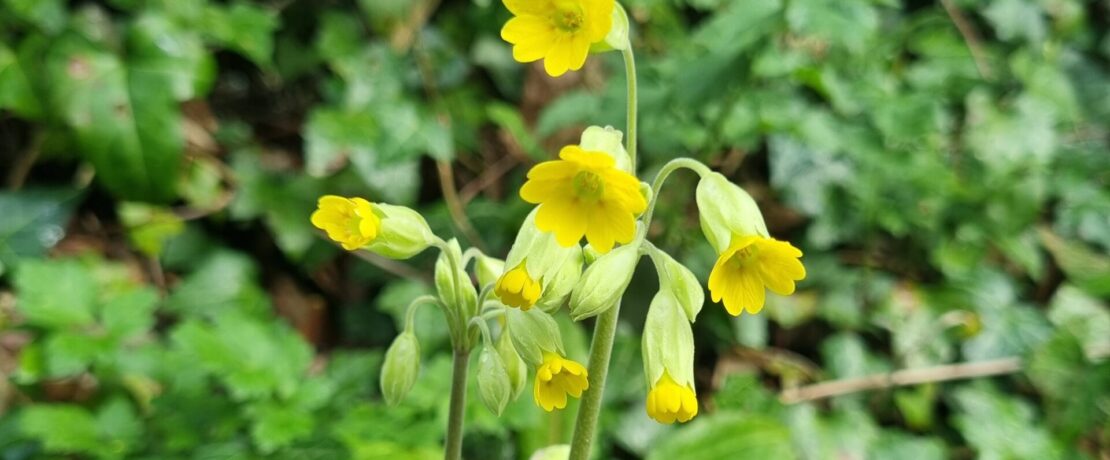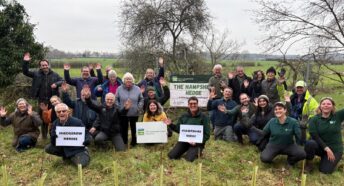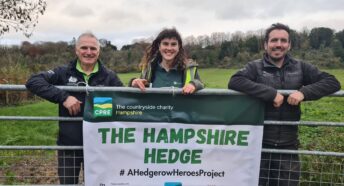Hedgerow Discovery Walk in Lasham
Our Hedgerow Project Officer, Ellie Banks, led a successful Hedgerow Discovery Walk in Lasham as part of the Alton Walking Festival.
The festival encourages enthusiastic walkers, relaxed wanderers, and curious explorers of all ages to explore the superb Hampshire countryside.
During the walk, participants enjoyed learning about hedgerows’ history, cultural significance, biodiversity, and carbon sequestration value.
‘A history of hedgerows – People’s Trust for Endangered Species (ptes.org)
Hedgerow-timeline-final.pdf (ptes.org)
Exploration & Insights
The walk began with a discussion about the differences between garden and agricultural hedgerows in terms of shape, size, and species, followed by a journey along Lasham’s footpath towards Shalden village. We also explored how our relationship with hedgerows has changed over time and how the total length of hedgerows in the landscape has varied, with the most recent peak as a result of the Enclosures Acts in the 18th and 19th centuries. Participants compared and identified various hedgerow species during the walk, ranging from common plants like hawthorn to gooseberry, hops, and holly.
Community Engagement
The event attracted participants from across north-east Hampshire, including an Alton Town Councillor advocating for increased hedgerow and tree planting, and a member of an Alton nature group actively involved in planting hedgerows and flower verges.

Key learning points
We discussed the importance of a biodiverse hedge, providing a variety of forage as well as for an extended season; blackthorn for early blossoms and guelder rose for the late, supporting populations to complete their life cycles. Hazel provides autumn forage for hazel dormice, but without the blossoms in spring from other hedgerow species they would not be able to survive.
Hedgerow plant diversity – People’s Trust for Endangered Species (ptes.org)
A-hedgerows-year-with-species-names-scaled.jpg (2560×1810) (ptes.org)
Not only focusing on the woody hedgerow species that make up the bulk of the hedge, we looked at the vital grassy margin home to wildflowers including red campion, cow parsley, stitchwort and foxgloves. We compared the climbers to one another such as traveller’s joy, black bryony, honeysuckle, ivy and hops, and looked above us at the trees known as ‘standards’ that dramatically broaden the dynamic nature of a hedgerow proving perching and nesting sites for birds of prey and bats, as well as all the benefits to insects that rely on more mature tree species. Hedgerow trees can also be important food sources during the autumns and winters when the hedgerow is managed through trimming or laying.
The structure of a hedge – People’s Trust for Endangered Species (ptes.org)
A-good-wildlife-hedge-structure-PTES.jpg (1754×1240)
Looking at the variety of hedgerow shapes, heights and sizes, we discussed the need for hedgerows to be treated as dynamic habitats, unable to remain in a static shape year after year. We discussed the benefits of trimming on a rotation, or incremental trimming leaving 2nd year wood encouraging an abundance flowers and berries. Referring to the hedgerow management cycle created by the People’s Trust for Endangered Species based from the Adams Code by Nigel Adams, we looked at how hedgerows in different states and conditions can be connected to one another through the cycle by choices to manage, or not manage a hedge. Following the simple diagram for advice, you can place your own hedgerow on the cycle and follow the simple advice to bring it back into ‘prime of life’ condition. Although hedgerows of all shapes and sizes can be celebrated providing a dynamic choice of habitat to all the wildlife that use and rely on them, raised base canopies, knuckles and gaps are all signs of mis-management and following this simple guide can tell you what you can do about it.
Top tips for managing hedgerows – People’s Trust for Endangered Species (ptes.org)
Hedgerow-management.jpg (2481×1754) (ptes.org)
Visit our events page to learn more about CPRE Hampshire’s upcoming events or sign-up to our e-newsletter to receive updates directly to your email inbox.











